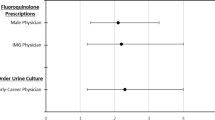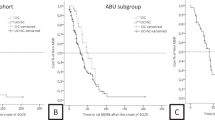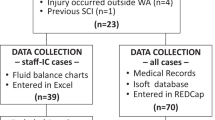Abstract
Objective
The Veterans Health Administration (VHA), the largest single provider of spinal cord injury and disorder (SCI/D) care in the United States, currently mandates that every patient receives a screening urine culture during the annual evaluation, a yearly comprehensive history and physical examination. This testing has shown in a small subset of patients to overidentify asymptomatic bacteriuria that is then inappropriately treated with antibiotics. The objective of the current analysis was to assess the association of the annual evaluation on urine testing and antibiotic treatment in a national sample of Veterans with SCI/D.
Design/Method
A retrospective cohort study using national VHA electronic health record data of Veterans with SCI/D seen between October 1, 2017-September 30, 2019 for their annual evaluation.
Results
There were 9447 Veterans with SCI/D who received an annual evaluation; 5088 (54%) had a urine culture obtained. 2910 cultures (57%) were positive; E. coli was the most common organism obtained (12.9% of total urine cultures). Of the patients with positive urine cultures, 386 were prescribed antibiotics within the 7 days after that encounter (13%); of the patients with negative cultures (n = 2178), 121 (6%) were prescribed antibiotics; thus, a positive urine culture was a significant driver of antibiotic use (p < 0.001).
Conclusion
The urine cultures ordered at the annual exam are often followed by antibiotics; this practice may be an important target for antibiotic stewardship programs in SCI.
This is a preview of subscription content, access via your institution
Access options
Subscribe to this journal
Receive 12 print issues and online access
$259.00 per year
only $21.58 per issue
Buy this article
- Purchase on Springer Link
- Instant access to full article PDF
Prices may be subject to local taxes which are calculated during checkout


Similar content being viewed by others
Data availability
The data that supports the findings of this study are available from the Veterans Health Administration but restrictions apply to the availability of these data, which were used under license for the current study, and so are not publicly available. Data are however available from the authors upon reasonable request and with permission of the Veterans Health Administration.
References
Dellit TH, Owens RC, McGowan JE, Gerding DN, Weinstein RA, Burke JP, et al. Infectious Diseases Society of America and the Society for Healthcare Epidemiology of America guidelines for developing an institutional program to enhance antimicrobial stewardship. Clin Infect Dis. 2007;44:159–77. https://doi.org/10.1086/510393.
Skelton F, Suda K, Evans C, Trautner B. Effective antibiotic stewardship in spinal cord injury: challenges and a way forward. J Spinal Cord Med. 2019;42:251–4. https://doi.org/10.1080/10790268.2017.1396183.
Skelton-Dudley F, Doan J, Suda K, Holmes SA, Evans C, Trautner B. Spinal cord injury creates unique challenges in diagnosis and management of catheter-associated urinary tract infection. Top Spinal Cord Inj Rehabil. 2019;25:331–9. https://doi.org/10.1310/sci2504-331.
Nicolle LE, Gupta K, Bradley SF, Colgan R, DeMuri GP, Drekonja D, et al. Clinical practice guideline for the management of asymptomatic bacteriuria: 2019 update by the Infectious Diseases Society of Americaa. Clin Infect Dis. 2019. https://doi.org/10.1093/cid/ciy1121.
Hooton TM, Bradley SF, Cardenas DD, Colgan R, Geerlings SE, Rice JC, et al. Diagnosis, prevention, and treatment of catheter-associated urinary tract infection in adults: 2009 International Clinical Practice Guidelines from the Infectious Diseases Society of America. Clin Infect Dis. 2010;50:625–63.
VHA 1176.01: Spinal Cord Injury and Disorders System of Care. https://www.va.gov/vhapublications/ViewPublication.asp?pub_ID=8523.
Skelton F, Grigoryan L, Holmes SA, Poon IO, Trautner B. Routine urine testing at the spinal cord injury annual evaluation leads to unnecessary antibiotic use: a pilot study and future directions. Arch Phys Med Rehabil. 2018;99:219–25. https://doi.org/10.1016/j.apmr.2017.10.005.
Fitzpatrick MA, Suda KJ, Safdar N, Goldstein B, Jones MM, Poggensee L, et al. Unique risks and clinical outcomes associated with extended-spectrum β-lactamase enterobacteriaceae in veterans with spinal cord injury or disorder: a case-case-control study. Infect Control Hosp Epidemiol. 2016:1–9. https://doi.org/10.1017/ice.2016.60.
Fitzpatrick MA, Suda KJ, Safdar N, Burns SP, Jones MM, Poggensee L, et al. Changes in bacterial epidemiology and antibiotic resistance among veterans with spinal cord injury/disorder over the past 9 years. J Spinal Cord Med. 2017:1–9. https://doi.org/10.1080/10790268.2017.1281373.
Gardner BJ, Pedersen JG, Campbell ME, McClay JC. Incorporating a location-based socioeconomic index into a de-identified i2b2 clinical data warehouse. J Am Med Inf Assoc. 2019;26:286–93. https://doi.org/10.1093/jamia/ocy172.
Skelton F, Salemi JL, Akpati L, Silva S, Dongarwar D, Trautner BW, et al. Genitourinary complications are a leading and expensive cause of emergency department and inpatient encounters for persons with spinal cord injury. Arch Phys Med Rehabil. 2019. https://doi.org/10.1016/j.apmr.2019.02.013.
Chew AB, Suda KJ, Patel UC, Fitzpatrick MA, Ramanathan S, Burns SP, et al. Long-term prescribing of nitrofurantoin for urinary tract infections (UTI) in veterans with spinal cord injury (SCI). J Spinal Cord Med. 2018:1–9. https://doi.org/10.1080/10790268.2018.1488096.
Drekonja DM, Trautner B, Amundson C, Kuskowski M, Johnson JR. Effect of 7 vs 14 days of antibiotic therapy on resolution of symptoms among afebrile men with urinary tract infection: a randomized clinical trial. JAMA. 2021;326:324–31. https://doi.org/10.1001/jama.2021.9899.
Author information
Authors and Affiliations
Contributions
SM was responsible for the overall writing of the manuscript, and FS was responsible for overseeing all aspects of the manuscript. All other authors contributed equally to study design, data collection and editing/revision of final manuscript.
Corresponding author
Ethics declarations
Competing interests
The authors declare no competing interests.
Additional information
Publisher’s note Springer Nature remains neutral with regard to jurisdictional claims in published maps and institutional affiliations.
Rights and permissions
About this article
Cite this article
May, S., Walder, A., Hines-Munson, C. et al. Impact of routine urine cultures on antibiotic usage in those undergoing a routine annual spinal cord injury evaluation. Spinal Cord 61, 684–689 (2023). https://doi.org/10.1038/s41393-023-00938-7
Received:
Revised:
Accepted:
Published:
Issue Date:
DOI: https://doi.org/10.1038/s41393-023-00938-7



